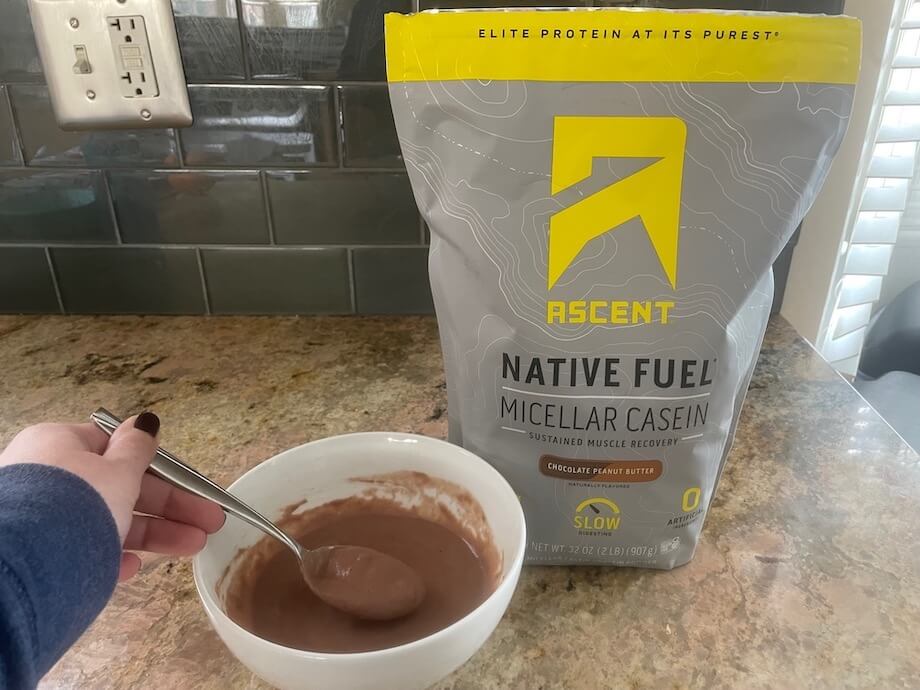We test and review fitness products based on an independent, multi-point methodology. If you use our links to purchase something, we may earn a commission. Read our disclosures.
I get it; even if you have the best protein powder in your house, taking it to hit your daily protein goal can be a real chore. Getting that extra protein in by mixing the same protein powder in the same milk or water gets to be monotonous. You crave something different.
Well, I’ve got a treat for you then, reader. Today we’ll be going over how to use protein powder—not just how to mix it in a shaker cup, but some easy, creative ways to enrich a high-protein diet. Protein powder can be used in a multitude of ways, and mixed with different whole foods, to create a vastly different experience for you in your quest to gain muscle or lose weight.
I also talked with Meagan O’Connor, RD, a sports dietitian for USA Weightlifting, about some of the health benefits of using protein powder. She has helped me through my Olympic weightlifting journey over the past several years, and if you’re still on the fence about why you might need protein powder, we’ll go over some of the reasons it can be beneficial to anyone.
Medical disclaimer: This article is intended for educational and informational purposes only. It is not intended as a substitute for medical advice. For health advice, contact a licensed healthcare provider.
Types of Protein Powder
There are many different types of protein available, with a variety of uses. Here is a quick breakdown of some of the more popular types of protein powders.
Whey Protein
Whey is derived from dairy, and is a liquid formed during the cheesemaking process, separated from curds. After the liquid is collected, the protein is separated from the carbohydrates and fats and dried into a powder—whey protein powder.
Whey protein is one of the most popular proteins available, as it has been shown to aid in building muscle when combined with strength training1. It also contains all essential amino acids. There are three types of whey protein:
- Whey protein isolate has the greatest amount of protein and lowest amount of fat, usually containing at least 90% protein2.
- Whey protein concentrate has not been as processed and will contain a higher amount of fat and lactose than isolate.
- Whey protein hydrolysate has partially been broken down through hydrolysis. This makes it easier to digest and is useful for those with gastrointestinal issues or those who train frequently and at high intensities.
Casein Protein
Casein protein is also derived from milk, and is actually made of the curds leftover in the cheesemaking process. Casein protein powder breaks down slower than whey protein; because of this, casein is a popular protein to take before bed, so the protein can break down and metabolize overnight.
Plant Protein
Plant-based protein powders are exactly what the name implies: the protein powder is derived from high-protein, plant-based foods—soybeans, chia seeds, hemp seeds—creating an alternative quality protein for vegan or vegetarian diets, or for those who are lactose-intolerant—just a few of the many plant-based protein powder benefits. Some popular plant-based proteins are:
- Soy protein
- Pea protein
- Hemp protein
- Chia protein
RELATED: Best Vegan Protein Powders
Egg Protein
While a good alternative to whey or casein protein for those who are lactose-intolerant, egg protein isn’t as popular of a source of protein. Many egg proteins, although not all, can have strong egg smells and tastes to them.
Ways to Use Protein Powder
The most common way to have protein powder is through a protein shake: just mix your preferred protein supplement into water, dairy milk, non-dairy milk like almond milk, and blend it up in a shaker cup until it’s mixed. While a quick and convenient way to get some extra grams of protein into your diet, it can start to get old, even with different flavors.
Here are some creative and easy ways to change up how to get your protein content, so you’re not dreading that post-workout shake.
Smoothie
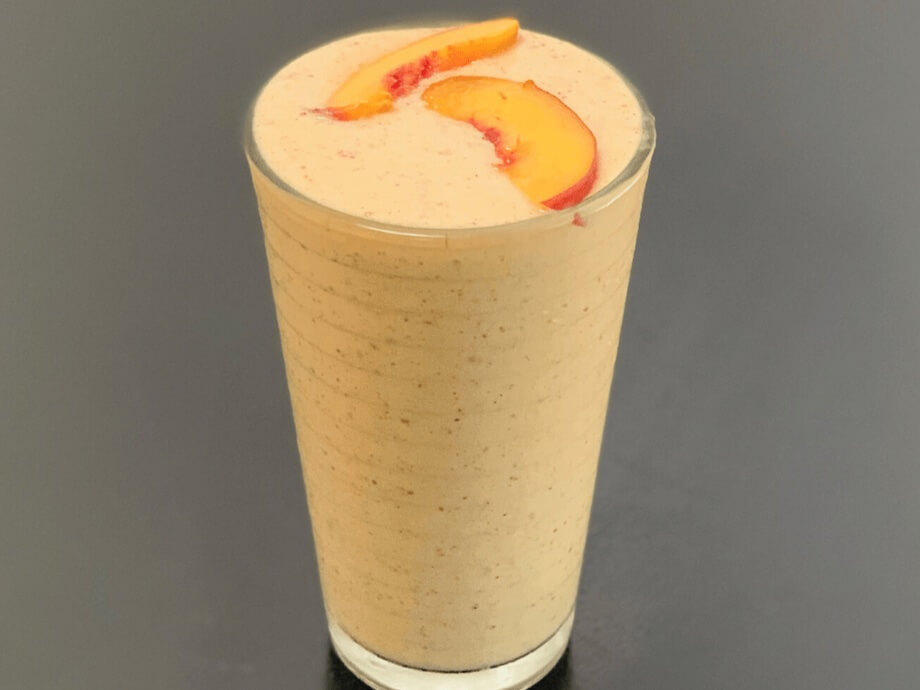
A protein smoothie is pretty much an elevated protein shake, and can also be used as a meal replacement if you’re in a rush. Start with milk or almond milk in a blender and add your desired flavor and amount of protein. Then add vegetables, fruit, or peanut butter—whatever you’d like. This is a great way to get protein, carbs, and fats on the go in one quick smoothie, and you can adjust it to your wants and needs.
RELATED: Best Protein Powder for Smoothies
If you need inspiration, you can check out this peach and mango protein smoothie recipe from Andrea Marincovich, RD, of therealisticdietitian.com.
Pancakes
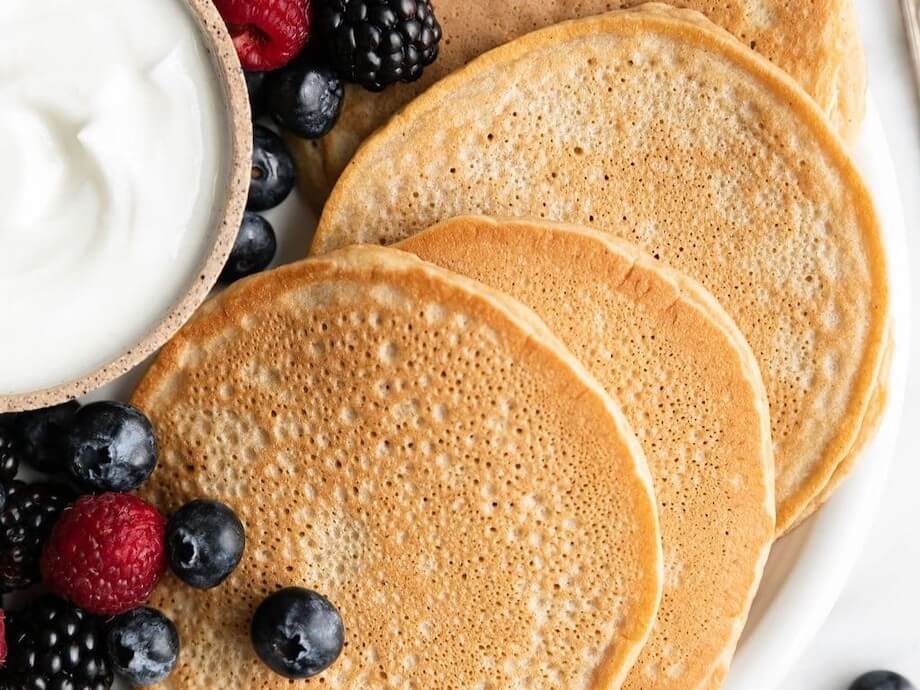
If you struggle to get enough protein in your breakfast, add some high-quality protein to your favorite pancakes in the morning. You can find and use a specific protein pancake recipe, or simply add a scoop of protein powder to your favorite pancake recipe that you’re already using.
RELATED: Dietitian-Approved High-Protein Breakfast Ideas
You can change it up with different fillings, such as chocolate chips or bananas. You can also change up the flavor of your protein powder; go beyond chocolate and vanilla. I used cookies and cream protein powder with my pancakes once, and it was delectable.
Tired of bananas in your protein pancakes? Try this banana-free protein pancakes recipe by Stacie Hassing, RDN, LD, from therealfooddietitians.com.
Coffee
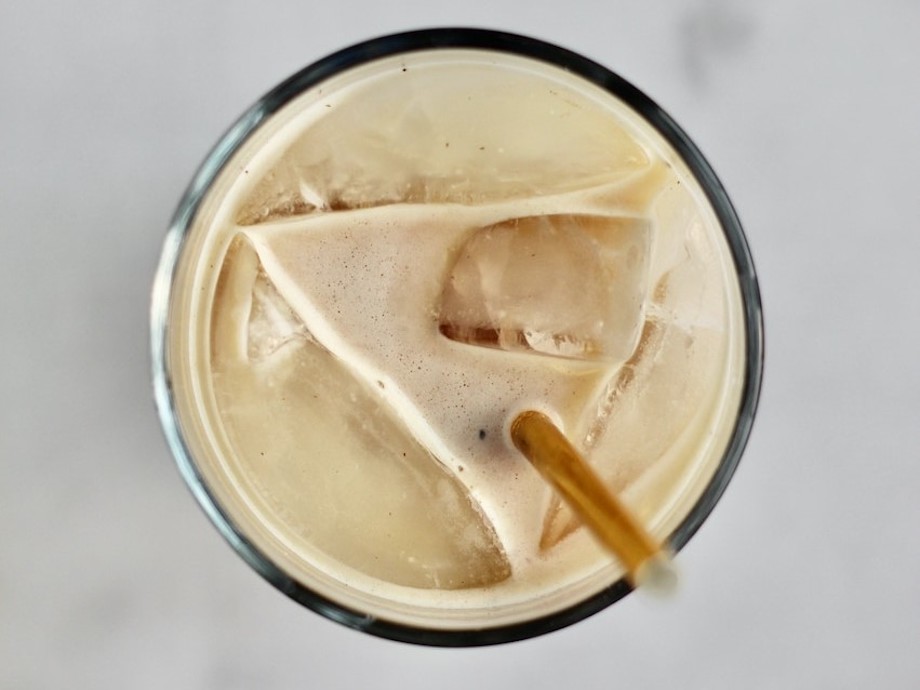
Another nice way to increase your protein intake in the morning is to add protein to your coffee. You can simply add a scoop of powder to your typical morning coffee. My wife uses an unflavored collagen supplement with her coffee and cream in the morning, just to get a bit of protein when she is on the run for work.
If you’re not in a rush in the morning, you can be creative and make yourself a sweet treat, adding protein to coffee, cream, and some syrup of your choosing, and blending or frothing the mixture to make a sweet latte. Check out this simple proffee (protein coffee) recipe from Registered Dietitian Nutritionist Mackenzie of cheerfulchoices.com.
Yogurt
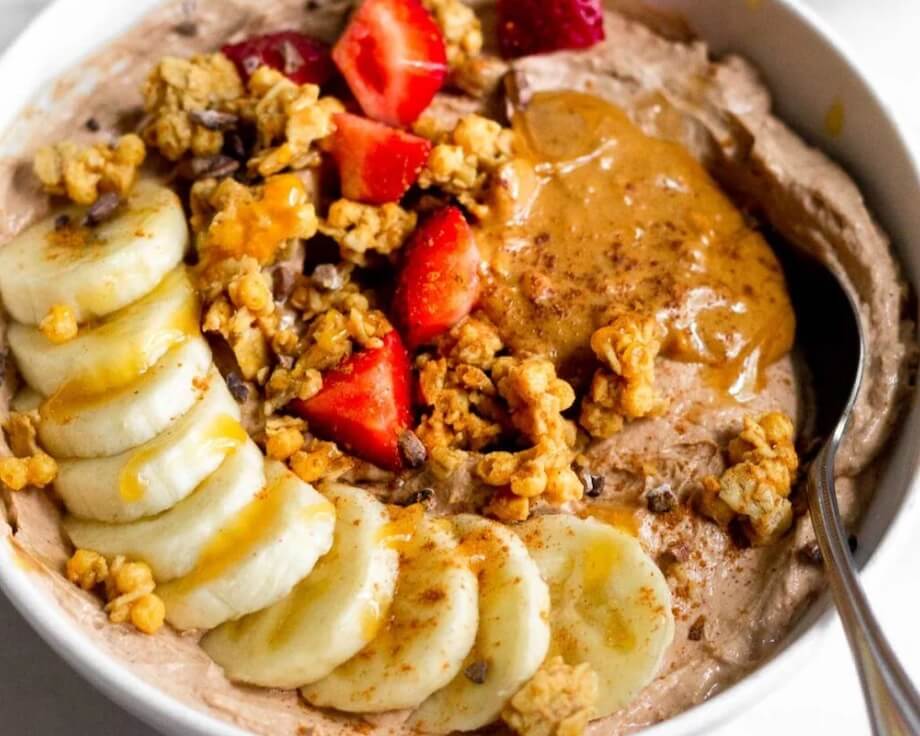
Yogurt is a fantastic and quick way to have some protein. Simply mix a scoop of protein into your yogurt and add fruit or toppings as desired. I like mixing Greek yogurt with vanilla protein, and adding strawberries and blueberries to the mix. I’ll even add a dash of stevia to sweeten the dish, making it great as a post-workout recovery dessert. You can also sprinkle oats on it for texture, and some almond butter for a good source of fat.
If you’re looking for inspiration, here is a protein-packed yogurt bowl recipe made by Kelly, a Nutritional Therapy Practitioner from eatthegains.com
Pudding
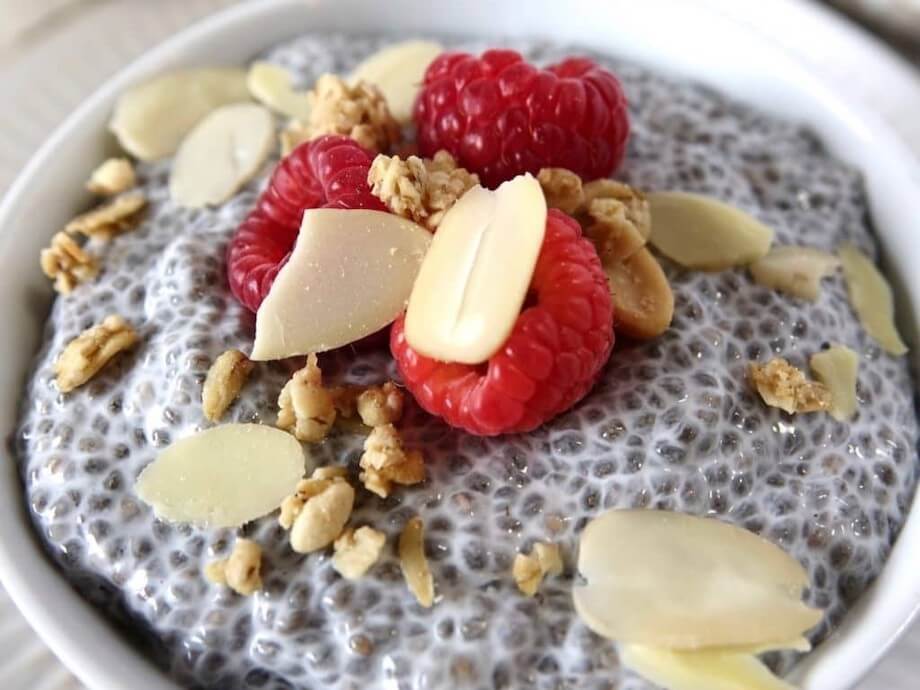
Easy to make, protein and milk can be mixed together for a thick pudding. For it, just mix a scoop of protein powder in a bowl with a little bit of milk. Add a little bit of milk at a time, until the mixture has the consistency of pudding. For a thinner pudding, just add a little more liquid.
Once you have the consistency you want, then just top with bananas, peanut butter, or other fruit, and enjoy! This is a great option for casein protein as a sweet treat before bed—casein tends to be thicker than whey so it’s perfectly suited for protein pudding.
You can take a look at this high-protein chia pudding recipe for inspiration—from registered dietitian Miranda of reallifenutritionist.com.
Brownies, Muffins, & Breads
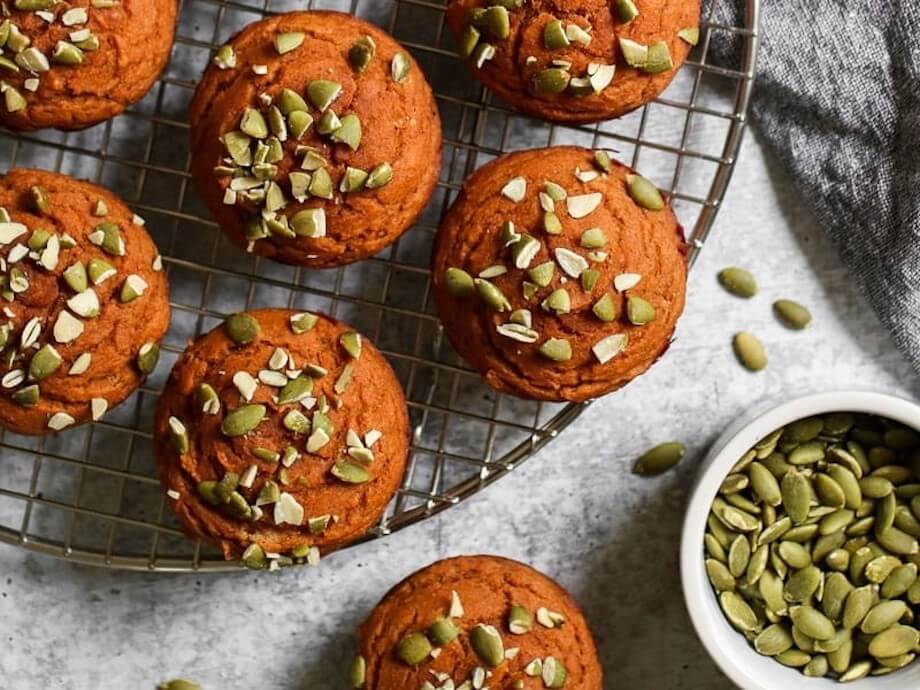
Who knew you could use protein powder as a baking ingredient? Actually, adding protein to your favorite baked goods is a common practice, and protein mixes well with virtually any baked good. Just like the pancakes, you can add a scoop or two to virtually any recipe you want to try out—brownies, breads, muffins, or cookies, even.
Baking protein brownies or similar items will also help you prep protein snacks for the rest of the week. If you make a batch of muffins, you’ll have something for a morning protein meal, or a post-workout snack throughout the week.
Here’s an easy pumpkin protein muffin recipe from Jessie Shafer, RDN, of therealfooddietitians.com.
Overnight Oats
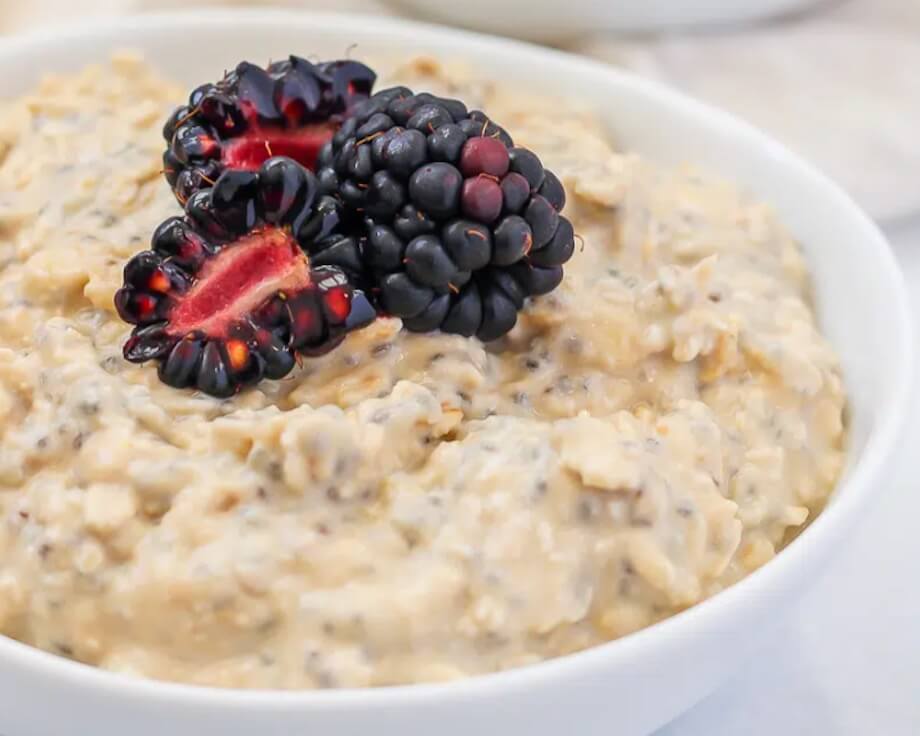
A great way to prepare yourself a high-fiber, high-protein meal in the morning is to make overnight oats. As the name implies, you prepare this the night before, and let the mixture of oats and milk thicken up overnight.
To prepare this snack, combine the oats with milk (usually in a 1:2 ratio), and add protein powder. Mix it up, and then top with fruit, seeds, cinnamon, or other desired toppings. Store in your fridge overnight. The texture should be creamy in the morning; mix this together well before eating.
Lindsay Janeiro, RDN, of nutritiontofit.com has a recipe for protein overnight oats that’s easy to prepare, if you’re looking for a good recipe to follow.
Benefits of Protein Powder
We just went over many ways to have this dietary supplement, but there’s more to protein powder than just being a tasty treat. Let’s take a closer look at some of the benefits of protein powder..
Meet Your Daily Protein Needs
“Protein powder can make it easier for anyone to meet their protein needs,” Meagan says about meeting daily recommended protein requirements. Ideally, we want the majority of our protein intake to come from whole food sources, but having a protein supplement in addition is a great and quick way to meet the quota of daily protein you need.
How much protein do you need? Meagan says the exact amount of protein someone needs at each meal will vary depending on the person. “However, research suggests about 0.25 to 0.3 grams of a complete protein per kilogram of body weight is enough to provide the necessary amino acids to support recovery and muscle protein synthesis.” This is per meal, and The International Society of Sports Nutrition1 supports this number as well.
At first glance, that isn’t a daunting number, but when you start to calculate daily protein needs, it can start to add up. That equates to about 1.2 to 2 grams of protein per kilogram of bodyweight each day for building muscle. If you’re busy most of the day, meeting that requirement through whole foods alone, can be a challenge, so protein powder provides a convenient and simple way to meet those numbers and get the most out of your protein intake.
Build Muscle
Muscle growth is one of the most well-known benefits of protein. You’ll often see bodybuilders and other gym-goers using high-protein meals to aid in building lean muscle mass, and using protein powder to make sure they are getting enough protein.
When I asked Meagan about the benefits of protein, building muscle was the first one she listed, saying that “Consuming protein is important to help support muscle growth, repair, and maintenance.”
According to a review from December 20193, muscle growth, or muscle hypertrophy, is dependent on a balance between resistance training and protein intake. The formation of new muscle proteins has to outweigh the breakdown of muscle proteins from strength training. Eating enough protein to exceed the breakdown of muscle proteins is vital, and done right will build muscle over time.
May Help in Muscle Recovery
In addition to muscle-building, protein can also help in recovering after a tough workout. Although there isn’t a clear consensus at this point, there are some studies to suggest that protein can help in recovery and delayed onset muscle soreness.
One study4 had men have a protein meal after a workout, and they showed signs of recovery within 48 hours, suggesting the macronutrient could aid in recovery. Another more recent study from April 20185 had active females take the fast-absorbing whey protein hydrolysate after a workout for four days. Each person showed signs of recovery in every metric measured.
Aid in Weight Loss
Protein can be filling, which is why protein powder and shakes or smoothies are often used as a meal replacement. Because of its filling nature, a high-protein diet can be helpful in losing weight. It’s not that protein is a weight loss supplement, though; rather, by meeting your daily protein needs each day, you’ll be full more often and less likely to overeat.
A research study from 20156 shows that a high-protein diet can help in losing or maintaining body weight, while losing primarily fat mass. It’s important to note that a high-protein diet in this study is 1.2 to 1.6 grams per kilogram of body weight.
If you are in the process of losing weight, it’s vital to keep protein intake up, Meagan says. “When trying to lose weight, it’s important to get adequate protein so that you can maintain as much lean body mass as possible while losing mostly body fat.” Making sure you are hitting your daily protein needs will help you lose fat while keeping lean mass as you lose weight.
How to Use Protein Powder: Final Thoughts
There are many ways to change up your protein intake, from simple and quick ways to have a high-protein snack, to baking it into your favorite foods. As much as protein can help you in your day-to-day life, it’s important to find ways to add it to your diet—while whole foods should always come first, protein powder can be an effective supplement to add to your daily routine. If the simple protein shake is just not cutting it for you anymore, make sure to try one of these fun and creative ways to use protein powder.
How to Use Protein Powder: Q&A
What is the best way to take protein powder?
There are many ways to have protein powder. The simplest and fastest method is to simply add a scoop of powder to water, milk, or a milk substitute, and mix it, typically in a shaker cup. If you have more time, or a protein shake is getting monotonous, there are plenty of ways to combine protein with other foods and drinks. It can be mixed with coffee, yogurt, and oatmeal, or you can combine it with your favorite baked goods—pancakes, muffins, brownies, cookies, and more.
What do you mix protein powder with?
Most protein powders mix well with water or milk, or a milk substitute like almond milk. You can be somewhat creative, however, and mix it with your morning coffee, too.
Is it better to take protein powder before or after a workout?
The best time to drink a protein shake is still being debated. While hitting your daily protein goal seems to be the most important factor, you can have protein powder before or after a workout for different reasons. A protein shake prior to a workout, especially with some good carbs like oats, will give you an energy boost and help you stay energized throughout the entire workout. Having a fast-absorbing protein like whey protein post-workout is good to get protein and amino acids to the muscles quickly to help repair and recover muscles fast.
These statements have not been evaluated by the Food and Drug Administration. This product is not intended to diagnose, treat, cure, or prevent any diseases.
References
- Jäger R, Kerksick CM, Campbell BI, Cribb PJ, Wells SD, Skwiat TM, Purpura M, Ziegenfuss TN, Ferrando AA, Arent SM, Smith-Ryan AE, Stout JR, Arciero PJ, Ormsbee MJ, Taylor LW, Wilborn CD, Kalman DS, Kreider RB, Willoughby DS, Hoffman JR, Krzykowski JL, Antonio J. International Society of Sports Nutrition Position Stand: protein and exercise. J Int Soc Sports Nutr. 2017 Jun 20;14:20. doi: 10.1186/s12970-017-0177-8. PMID: 28642676; PMCID: PMC5477153.
- Madureira AR, Pereira CI, Gomes AMP, Pintado ME, Xavier Malcata F. Bovine whey proteins – Overview on their main biological properties. Food Res Int. 2007 Dec;40(10):1197–211. doi: 10.1016/j.foodres.2007.07.005. Epub 2007 Aug 3. PMCID: PMC7126817.
- Krzysztofik M, Wilk M, Wojdała G, Gołaś A. Maximizing Muscle Hypertrophy: A Systematic Review of Advanced Resistance Training Techniques and Methods. Int J Environ Res Public Health. 2019 Dec 4;16(24):4897. doi: 10.3390/ijerph16244897. PMID: 31817252; PMCID: PMC6950543.
- Etheridge T, Philp A, Watt PW. A single protein meal increases recovery of muscle function following an acute eccentric exercise bout. Appl Physiol Nutr Metab. 2008 Jun;33(3):483-8. doi: 10.1139/H08-028. PMID: 18461101.
- Brown MA, Stevenson EJ, Howatson G. Whey protein hydrolysate supplementation accelerates recovery from exercise-induced muscle damage in females. Appl Physiol Nutr Metab. 2018 Apr;43(4):324-330. doi: 10.1139/apnm-2017-0412. Epub 2017 Nov 6. PMID: 29106812.
- Leidy HJ, Clifton PM, Astrup A, Wycherley TP, Westerterp-Plantenga MS, Luscombe-Marsh ND, Woods SC, Mattes RD. The role of protein in weight loss and maintenance. Am J Clin Nutr. 2015 Jun;101(6):1320S-1329S. doi: 10.3945/ajcn.114.084038. Epub 2015 Apr 29. PMID: 25926512.
Further reading

The Good Kitchen Review: Tasted and Tested by Experts (%currentyear%) %sep% %sitename% Read more

The landmine press activates the chest, shoulders, triceps, and core. Here’s how to do the landmine press with proper form, the benefits, and variations. Read more

We have to get branched-chain amino acids through our diet. This Naked BCAAs review can help you decide if Naked Nutrition’s supplement can meet your needs. Read more

The best fish oil supplements provide essential omega-3 fatty acids through EPA and DHA. These are our dietician-reviewed top picks to meet your needs! Read more

